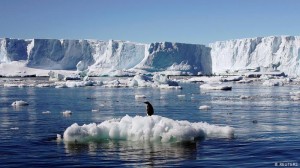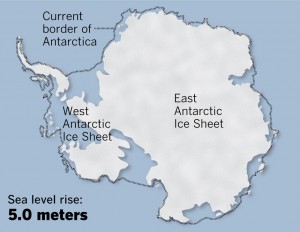From an Article by Jessica Corbett, Common Dreams News, 4/9/21
A new study is shedding light on just how much ice could be lost around Antarctica if the international community fails to urgently rein in planet-heating emissions, bolstering arguments for bolder climate policies.
The study, published Thursday in the journal Geophysical Research Letters, found that over a third of the area of all Antarctic ice shelves—including 67% of area on the Antarctic Peninsula—could be at risk of collapsing if global temperatures soar to 4°C above pre-industrial levels.
An ice shelf, as NASA explains, “is a thick, floating slab of ice that forms where a glacier or ice flows down a coastline.” They are found only in Antarctica, Greenland, Canada, and the Russian Arctic—and play a key role in limiting sea level rise.
“Ice shelves are important buffers preventing glaciers on land from flowing freely into the ocean and contributing to sea level rise,” explained Ella Gilbert, the study’s lead author, in a statement. “When they collapse, it’s like a giant cork being removed from a bottle, allowing unimaginable amounts of water from glaciers to pour into the sea.”
“We know that when melted ice accumulates on the surface of ice shelves, it can make them fracture and collapse spectacularly,” added Gilbert, a research scientist at the University of Reading. “Previous research has given us the bigger picture in terms of predicting Antarctic ice shelf decline, but our new study uses the latest modelling techniques to fill in the finer detail and provide more precise projections.”
Gilbert and co-author Christoph Kittel of Belgium’s University of Liège conclude that limiting global temperature rise to 2°C rather than 4°C would cut the area at risk in half. “At 1.5°C, just 14% of Antarctica’s ice shelf area would be at risk,” Gilbert noted in The Conversation.
While the 2015 Paris climate agreement aims to keep temperature rise “well below” 2°C, with a more ambitious 1.5°C target, current emissions reduction plans are dramatically out of line with both goals, according to a United Nations analysis.
Gilbert said Thursday that the findings of their new study “highlight the importance of limiting global temperature increases as set out in the Paris agreement if we are to avoid the worst consequences of climate change, including sea level rise.” And, “If temperatures continue to rise at current rates,” she said, “we may lose more Antarctic ice shelves in the coming decades.” Also, “Limiting warming will not just be good for Antarctica — preserving ice shelves means less global sea level rise, and that’s good for us all,” Gilbert added.
The researchers warn that Larsen C—the largest remaining ice shelf on the Antarctic peninsula—as well as the Shackleton, Pine Island, and Wilkins ice shelves are most at risk under 4°C of warming because of their geography and runoff predictions.
Low-lying coastal areas such as small island nations of Vanuatu and Tuvalu in the South Pacific Ocean face the greatest risk from sea level rise, Gilbert told CNN. “However, coastal areas all over the world would be vulnerable,” she warned, “and countries with fewer resources available to mitigate and adapt to sea level rise will see worse consequences.”
Research published in February examining projections from the Fifth Assessment Report of the U.N. Intergovernmental Panel on Climate Change as well as the body’s Special Report on the Ocean and Cryosphere in a Changing Climate found that sea level rise forecasts for this century “are on the money when tested against satellite and tide-gauge observations.”
A co-author of that study, John Church of the Climate Change Research Center at the University of New South Wales, said at the time that “if we continue with large ongoing emissions as we are at present, we will commit the world to meters of sea level rise over coming centuries.”
Parties to the Paris agreement are in the process of updating their emissions reduction commitments—called nationally determined contributions—ahead of November’s United Nations climate summit, known as COP26.
>>>>>>>>……………………>>>>>>>>……………………>>>>>>>>
See also: ‘A dire prediction’ on melting ice sheets and rising sea levels – Los Angeles Times, April 7, 2016
>>>>>>>>>>…………………………>>>>>>>>>>
See also: “Will the world ever be all under water?” | Ed Mathez, American Museum of Natural History (AMNH)
If all the ice covering Antarctica , Greenland, and in mountain glaciers around the world were to melt, sea level would rise about 70 meters (230 feet). The ocean would cover all the coastal cities.



{ 1 comment… read it below or add one }
Unsettling currents: Warm water flowing beneath the ‘Doomsday Glacier’: Data from underneath Thwaites Glacier, also known as the Doomsday Glacier
From K. J. Heywood, ScienceDaily, April 2021
For the first time, researchers have been able to obtain data from underneath Thwaites Glacier, also known as the “Doomsday Glacier.” They find that the supply of warm water to the glacier is larger than previously thought, triggering concerns of faster melting and accelerating ice flow.
With the help of the uncrewed submarine Ran that made its way under Thwaites glacier front, the researchers have made a number of new discoveries. Professor Karen Heywood of the University of East Anglia commented:
“This was Ran’s first venture to polar regions and her exploration of the waters under the ice shelf was much more successful than we had dared to hope. We plan to build on these exciting findings with further missions under the ice next year.”
The submersible has, among other things, measured the strength, temperature, salinity and oxygen content of the ocean currents that go under the glacier.
Global sea level is affected by how much ice there is on land, and the biggest uncertainty in the forecasts is the future evolution of the West Antarctic Ice Sheet, says Anna Wåhlin, professor of oceanography at the University of Gothenburg and lead author of the new study now published in Science Advances.
Impacts global sea level
The ice sheet in West Antarctica accounts for about ten percent of the current rate of sea level rise; but also the ice in West Antarctica holds the most potential for increasing that rate because the fastest changes worldwide are taking place in the Thwaites Glacier. Due to its location and shape, Thwaites is particularly sensitive to warm and salty ocean currents that are finding their way underneath it.
This process can lead to an accelerated melting taking place at the bottom of the glacier and inland movement of the so-called grounding zone, the area where the ice transitions from resting on the seabed to floating in the ocean.
Due to its inaccessible location, far from research stations, in an area that is usually blocked by thick sea ice and many icebergs, there has been a great shortage of in situ measurements from this area. This means that there are big knowledge gaps for the ice-ocean boundary processes in this region.
First measurements performed
In the study, the researchers present the results from the submersible that measured strength, temperature, salinity and oxygen content of the ocean currents that go under the glacier.
“These were the first measurements ever performed beneath Thwaites glacier,” says Anna Wåhlin.
The results have been used to map the ocean currents underneath the floating part of the glacier. The researchers discovered that there is a deep connection to the east through which deep water flows from Pine Island Bay, a connection that was previously thought to be blocked by an underwater ridge.
The research group has also measured the heat transport in one of the three channels that lead warm water towards Thwaites Glacier from the north. “The channels for warm water to access and attack Thwaites weren’t known to us before the research. Using sonars on the ship, nested with very high-resolution ocean mapping from Ran, we were able to find that there are distinct paths that water takes in and out of the ice shelf cavity, influenced by the geometry of the ocean floor” says Dr Alastair Graham, University of Southern Florida.
The value measured there, 0.8 TW, corresponds to a net melting of 75 km3 of ice per year, which is almost as large as the total basal melt in the entire ice shelf. Although the amount of ice that melts as a result of the hot water is not much compared to other global freshwater sources, the heat transport has a large effect locally and may indicate that the glacier is not stable over time.
Not sustainable over time
The researchers also noted that large amounts of meltwater flowed north away from the front of the glacier.
Variations in salinity, temperature and oxygen content indicate that the area under the glacier is a previously unknown active area where different water masses meet and mix with each other, which is important for understanding the melting processes at the base of the ice.
The observations show warm water approaching from all sides on pinning points, critical locations where the ice is connected to the seabed and give stability to the ice shelf. Melting around these pinning points may lead to instability and retreat of the ice shelf and, subsequently, the upstream glacier flowing off the land. Dr Rob Larter of the British Antarctic Survey commented:
“This work highlights that how and where warm water impacts Thwaites Glacier is influenced by the shape of the sea floor and the ice-shelf base as well as the properties of the water itself. The successful integration of new sea-floor survey data and observations of water properties from the Ran missions shows the benefits of the multidisciplinary ethos within the International Thwaites Glacier Collaboration.”
“The good news is that we are now, for the first time, collecting data that is necessary to model the dynamics of Thwaite’s glacier. This data will help us better calculate ice melting in the future. With the help of new technology, we can improve the models and reduce the great uncertainty that now prevails around global sea level variations.” says Anna Wåhlin.
Journal Reference:
A. K. Wåhlin, A. G. C. Graham, K. A. Hogan, B. Y. Queste, L. Boehme, R. D Larter, E. C. Pettit, J. Wellner and K. J. Heywood. Pathways and modification of warm water flowing beneath Thwaites Ice Shelf, West Antarctica. Science Advances, 2021 DOI: 10.1126/sciadv.abd7254